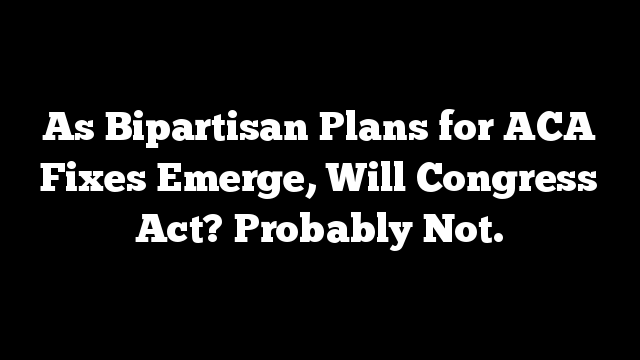By STEVEN FINDLAY
 A bipartisan group of health policy experts has issued a call to action and well-thought-out consensus plan for insurance market stabilization and incremental reform.
A bipartisan group of health policy experts has issued a call to action and well-thought-out consensus plan for insurance market stabilization and incremental reform.
The effort adds to the gathering momentum in Washington for urgent fixes to Obamacare, plus additional reforms that might bring conservatives into the fold and appeal across the partisan divide. What’s still unclear, however, is whether the Trump administration and Republican leadership in Congress will go along. Outward signs suggest they won’t, but this game is still changing by the day.
Trump continues to tweet-shame McConnell and the Senate Republicans for failing to repeal and replace the ACA, and conservatives in the House and Senate continue to insist they’ll oppose any “bailout” of the insurance industry. (In no way is stabilizing the insurance marketplaces an insurer bailout, any more than tax support of Medicare Advantage plans are a bailout.)
Most recently, on August 11, the House Freedom Caucus called on House Speaker Paul Ryan to bring a “clean” Obamacare repeal bill to the floor this fall.
While this tense and chaotic game of chicken persists, insurers, state insurance commissioners, exchange administrators, most of the health care industry, and millions of consumers fret, wait for clarity, explore options, ready contingencies, and prepare for the worst for open enrollment 2018.
Hope rests largely on two efforts underway in Congress:
(1) Pledges by a growing number of Democrats and moderate Republican Senators to step in and act, led by Sen. Lamar Alexander (R-Tenn.), chairman of the Health, Education, Labor and Pensions (HELP) Committee. He’s planning hearings in Sept. aimed at quickly crafting bipartisan legislation to shore up the exchanges.
(2) A proposal by a bipartisan coalition of 43 House members dubbed the “Problem Solvers Caucus.” The proposal shares a central thrust and actions and ideas with the policy experts’ plan, as listed and discussed below.
The problem is time. When Congress returns from summer recess the week of Sept. 4, it has only a few weeks to approve legislation before the Sept. 27 deadline for insurers’ to submit final proposals to states and the federal government to sell marketplace plans in 2018. The Trump administration can extend that deadline but that’s viewed as unlikely. Open enrollment for 2018 starts Nov. 1 and ends Dec. 15.
Some observers think it’s already too late to affect premiums for 2018. Insurers in almost every state have added supplemental premium increases (above those already planned) due to the uncertainty. Some states, like California, plan to telegraph loud and clear to consumers which plans are being hiked the most.
Courtesy of The Washington Post’s Paige Cunningham and the Kaiser Family Foundation (KFF), out of 20 states (plus DC) that have released enough information to analyze, insurers in 15 have proposed rate hikes in the double digits. Insurer participation in the marketplaces is also down but not as much as anticipated a few months ago. An average of 4.6 carriers intend to sell plans in 2018 compared to 5.1 carriers this year and 6.2 in 2016 in those same 20 states and DC.
HHS predicted this month, however, that as many as one third of U.S. counties—and especially those in the rural western states—might have just one insurer in the exchange in 2018.
The policy think-tankers—from organizations as diverse as the Hoover Institute, Families USA, The American Enterprise Institute and Brookings—recommend the following:
* Fund the cost sharing reduction (CSR) payments. These payments to insurers help reduce deductibles and co-payments for low-income exchange enrollees—critical to affordability. The cost: $8 to $10 billion a year in 2018 and 2019. The Trump administration has been paying the CSR bill month-by-month amid litigation over the legality of the payments dating back to the Obama Administration. Trump has personally threatened to cut the CSR payments off unless Congress repeals the ACA. It’s mainly these payments that some Republicans call a “bailout.”
* Reassess the “3 Rs”—risk adjustment, risk corridors and reinsurance—as tried-and-true ways to stabilize the exchange markets. All were in the ACA and played a key role in holding premium increases down from 2014 to 2016. But the reinsurance and risk-corridor programs terminated at the end of 2016. Risk adjustment is permanent but has been administered poorly. HHS should “give states wider latitude to tailor risk adjustment methodologies for their particular markets,” the group advises. HHS secretary Tom Price supports reinsurance, having invited all 50 governors in March to consider it as they sought to restrain premium increases.
* Continue enrollment assistance programs that inform consumers about the ACA benefits, and aid their enrollment.
* Address the needs of consumers in counties with no participating insurers in 2018 by permitting people to enroll in a plan sponsored by the Federal Employee Health Benefits Program (FEHBP). FEHBP has a presence in every state because there are federal employees in every state. Insurers could be required, for example, to offer such plans in “bare counties” as a condition of FEHBP participation.
* Permit states to explore alternatives to the individual mandate. A compromise could involve “combining incentives to purchase health insurance with effective sanctions for not enrolling or not maintaining coverage, including financial penalties and waiting periods,” the group said. The ACA’s Section 1332 currently allows states to propose waivers to explore alternatives to the mandate. The group also recommends that Congress modify Section 1332 to allow states to “integrate federal funds used to cover low income children, adults, and families under Medicaid and CHIP and private insurance to improve coverage and care delivery.”
* Permit states, more generally, to experiment with their health insurance markets. “We support enhanced financing flexibility for states that seek to increase access to affordable coverage for their low and moderate-income populations. Though we differ in our views regarding the scope of the guardrails that should be established, we encourage Congress to consult with states and others on how to refine the guardrails to provide enhanced flexibility.”
* Extend federal funding through 2019 for the Children’s Health Insurance Program (CHIP) and community health centers.
* Expand, judiciously, health savings accounts (HSAs) and health reimbursement accounts (HRAs), including using HSA funds for premium payments and reforms that make pre-funded HSAs available to lower income people who choose to enroll in high-deductible health plans.
